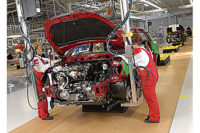In appliance applications where access to a unit or disassembly for service may be required, specialized types of self-clinching fasteners have been developed. Such "access hardware" (panel fastener assemblies with captive screws) can expedite MTTR (Mean Time To Repair), since captive screws reduce the number of parts to be handled by service technicians.
Their captive-screw design with the fastener as a permanent part of the assembly further eliminates the risk of loose hardware falling into power supplies or delicate circuitry during service or repairs in the field.
Some common appliance applications for access or panel fasteners include attaching service doors and panels, mounting chasses to frames in desktop computers and workstations, and attaching add-on components (fan trays, document loaders and hard drives).
The newest access hardware fastening product is the line of patented PEMR Type PFPT self-clenching fastener assemblies from Penn Engineering & Manufacturing Corp., Danboro, Pa.
As with other panel-fastener types, these install permanently in metal sheets as thin as .036 in./0.92mm, and the screw is captive without falling out. Unlike others, these metal/plastic panel fasteners uniquely feature a steel retainer and screw, and a large ABS plastic cap.
The cap, which is available in a range of optional colors, can act as a color identifier or used to color match with a panel or other component. The color cap can serve a wide range of functional purposes. Red could designate "technician-only" access areas and "green" could signal authorized and safe access for all users.
Finger spring action
While most self-clinching panel-fastener assemblies are spring loaded, this newest fastener achieves spring action via the cap's plastic "fingers," which allow the cap to be held in a retracted position. The retracting mechanism is actuated by the six fingers following the contour of the fastener's tapered retainer.When the cap is retracted, so is the screw, which prevents the screw from damaging, marring, or interfering with a mating panel when that panel is slid into place. Appliance-finish integrity results.
Access hardware, in particular, and self-clinching fasteners, in general, are often specified for appliance applications due to their low installed cost, inherent design benefits, and in-use performance.
Every self-clinching fastener is developed with a simple idea in mind: less is better. Why use several pieces of hardware when one simple, yet cost-effective, fastener will do the job?
For appliance manufacturers, self-clinching fasteners, including access hardware, usually require fewer assembly steps than many other types of fastening hardware. Hardware installation is performed during fabrication instead of during final assembly.
The need to stock or handle additional hardware, such as washers, lock washers, loose nuts or bolts during the component assembly or disassembly operation, is eliminated since the hardware becomes unnecessary.
Appearance enhancement
Self-clinching fasteners meet requirements for high pushout and torque-out resistances and for vibration and related parameters. They can enhance end-product appearance because their compact design allows flush installation in the panel.In many applications, they can support the switch to a thinner sheet metal or panel material, further reducing installed costs.
Regardless of type, all self-clinching fasteners are installed by pressing them into place in a properly sized drilled or punched hole. In turn, the displaced panel material cold flows into a specially designed annular recess in the shank or pilot of the fasteners, locking the fastener permanently in place.
Self-clinching fasteners become a permanent and integral part of the appliance component in which they are installed.

